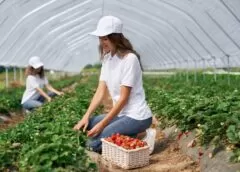It’s hard to find good produce in the store these days. Farmers use strip farming techniques to get a lot of watery fruit and vegetables instead of fewer quality products. If this is a problem that affects your life, read on how to make your organic garden at home!
Making your compost for organic gardening is extremely simple and easy to do. It provides the soil of gardens with rich nutrients and keeps soil cool during the summer months. You can use kitchen waste, sawdust, aquarium water, coffee grounds, tea leaves, rabbit or hamster droppings, a thin layer of lawn clippings, spices, and eggshells in your compost.
Coffee grounds and leftover coffee can be used to repel slugs. If you have an issue with slugs in your garden, you can repel them effectively with coffee. You can sprinkle coffee grounds on the soil around your plants or use leftover coffee in a spray bottle to spray the slugs directly.
Establish a precise schedule to know when you should plant your seeds. Even if you grow your plants indoors, you should follow a schedule that matches the season and outside temperature. Spend some time on your schedule at the beginning of a season, and you should be able to improve it the following year.
When participating in organic gardening, a great tip is always to wash your containers. This is needed to protect your plants from getting any diseases. It would be best to wash them in warm, soapy water and then rinse using a diluted solution of bleach and water. This will ensure that your plants stay healthy.
Do not overlook the benefits of pine mulch for your garden. Some plants need acidic soil to grow properly because of their acid content. There is no better or easier way to make your acid-loving plants happy than to use pine needles you already have on your beds. Cover the ground’s surface with a two-inch layer of pine needles; as the needles break down, they will release acid into the soil and nourish your plants.
Regulate how often you revitalize your soil based on your planting season. You might need to fertilize the ground more than once during a very long season. It’s essential to give your plants the proper nutrients to grow, and remember that the nutrients within the soil slowly diminish as plants grow. Having the correct amount at the correct time will promote your harvest to grow to its maximum size.
Use soap on your plants. Not much is worse than a bad aphid infestation. If the bugs continue to work on your plants, your plants will look terrible and eventually die. To get rid of them now, fill a spray bottle with dish soap and water. Spray thoroughly, and repeat as needed.
Fertilize your soil with organic compost. Organic gardeners tend to fertilize their soil twice in one season: once before planting and in the middle of a growth cycle. The best fertilizer to use is organic compost, as it releases nutrients slowly, unlike chemical fertilizers, which release nutrients in one go and then lose their effect.
Encourage toads to take up residence in your organic garden. Toads are a natural predator of many pesky bugs that will eat and destroy your crops. Create makeshift toad houses out of overturned broken clay pots and keep soil nice and moist to make it conducive to amphibian life.
Before you begin planting in your garden, it’s good to test your soil’s acidity first. Home testing kits are readily available. Your soil should have a pH of around 6.5 for most vegetables. If the pH is too low, you can boost it by spreading lime. If it’s too high, you can use powdered sulfur.
When it is harvest time, use a laundry basket. The laundry basket can be used as a colander for your produce. Just rinse the produce right in the basket; the water will drain through the holes.
When trying to add compost to your organic garden, find a better way to get the compost there. It can be a pain to move wheel-barrows of compost to your garden. You could try layering newspaper down the walkways of your garden and adding straw to the top. Near the end of the season, the compost will be ready to be added to your garden, and you only have to move it from the walkway to the beds on each side.
To insulate the soil and protect against weeds, you should consider different types of mulches. Use things like wood chips, leaves, hay, and lawn clippings. Protecting plants with a mulch helps them guard soil against erosion. You can even look into living mulches, which are plants that serve the same purpose as a mulch.
When planting your organic garden, wear a carpenter’s tool belt around your waist and fill all the pockets with your gardening gloves and tools. This will keep your tools organized and handy for use, and it will also minimize trips back and forth to your shed to retrieve tools you have forgotten to carry with you.
Be careful when moving your plants from plastic containers to the soil. Plants often end up with bound roots when they have spent too much time in plastic. Turn the plastic container upside-down slowly and tap gently to remove the plant. Avoid damaging the plant’s delicate root system.
When planting your tomato seedlings in your organic garden, you should plant them up to the first true leaves, which will bury the stem. The reason is that new roots will sprout on these buried stems. The more roots there are in a seedling, the more fruit it will produce.
An organic garden right in your home is a great thing to have. You’ll love the fresh, organic produce that you pull out of your backyard for free! Apply the tips from this article to stop relying on farmers, who are only out to make a quick buck. Start enjoying quality produce right from your own home.

